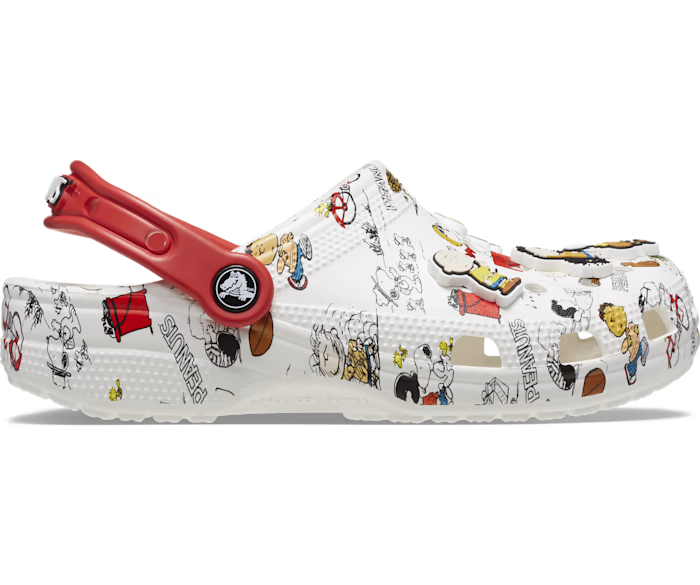How Should Running Shoes Fit- Find The Right Size Shoes

According to a 2018 study, much of the population wears incorrect shoe size, which is linked to foot pain and foot disorders, bordering on the need to educate people of the importance of correct sizing and introducing various sizes in footwear.
Hence, proper knowledge of how should running shoes fit is essential for runners, gym-goers, and sports enthusiasts.
We often let the idea of the perfect shoe size take a backseat, among other factors such as comfort, cushioning, breathability.
Most people make the mistake of assuming the best shoe will automatically have the perfect fit as well, right?
Wrong!
Because the perfect shoe size makes a perfect shoe, and if the former is wrong, everything else falls apart.
Even though most people are aware of picking the correct size, not all know how it’s done and what considerations to keep in mind. To help you sort out accurate sizing, our post details how should short or long distance running shoes fit.
I hope to answer all your questions and may even bring up points you hadn’t ever considered!
For starters, you need to do these three things to get your size right:
- Measure shoe size
- Use a sizing conversion chart to find your size.
- Make certain you have the right size.
How to measure shoe size?
Get a pen, paper, ruler, or measuring tape to measure your shoe size.
- Place the paper on a flat surface and wear socks you intend to wear with your running shoes. Stand with one foot flat on the paper, making sure your toes are straight.
- Outline your foot until you’ve achieved a foot shape. Hold the pen at a 90° degree angle — perpendicular — for an accurate result.
- The longest part of the foot is the height: the widest part of the foot will be the width as per the measurement. This is how to measure foot width and height.
- Repeat the same process for the other foot.
- If you have one larger foot than the other, then go with the measurements of the longer foot as your running shoe size because the larger foot will suffer most if your shoe size is incorrect.
How to Measure your Foot for Size Conversion Chart?
Once you have your foot measurements, match them up with the measurements provided on either the men’s or women’s size chart to find your correct shoe size. If your measurements sit between two sizes, simply round up and get an accurate size.
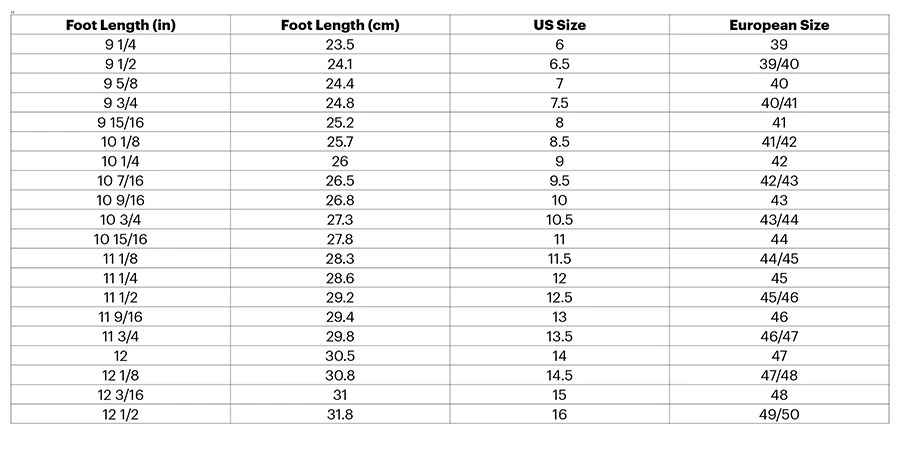
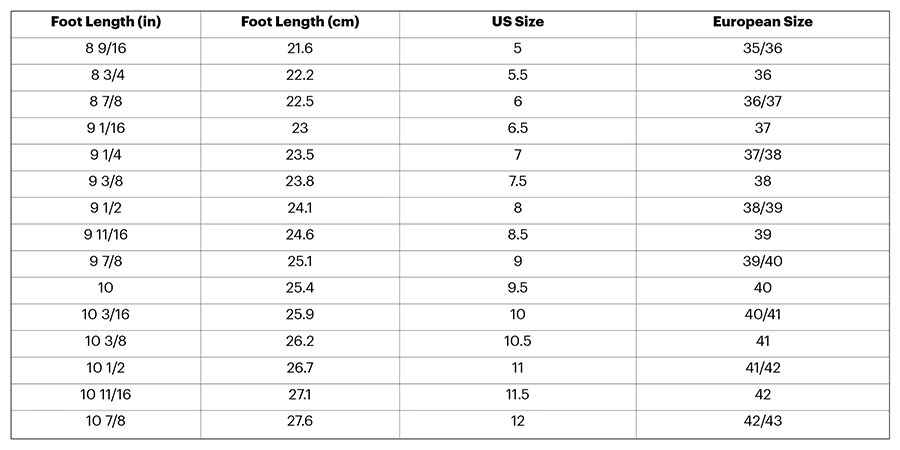
How to Find your Foot Width?
While you know how to measure foot size and get your measurements on the size conversion chart by now, one thing to keep in mind is not all sizes are made equal in terms of width.
Some people have naturally wider and naturally narrower feet than those with a standard width, although their shoe sizes may be the same. Because of this, you may have come across customer reviews complaining of a certain shoe running too wide or too narrow for their feet.
Don’t worry; I know exactly how to get around that issue, so you never have to face wider-sized or narrow shoe size problems again.
Find Your Perfect Size
To find the perfect shoe size, you need to know how wide is the bunion joint – the ball of your foot. In fact, an ideal fit also rests on how deep are your feet.
Therefore, the total volume of your foot is very important. If you have a low volume in the bunion joint (inspect from the bottom), you are a narrow medium.
A normal volume is a mix between medium and high width. In comparison, a high volume is simply extra wide.
To begin:
- Measure the widest part of your foot (the bunion joint) with your feet on the ground. Stand normally as you would.
- Find the measurements in millimeters.
- Find your width on a shoe chart for men or women, preferably on the UK or US chart since they’re most commonly used.
Also, bear in mind the shoe widths of men, women, and children are categorized by alphabets or words that convey the width ratio.
A/B Widths
Narrow And Extra Narrow Widths are defined by a letter, and anything more than “2A” is considered extra narrow in the female chart.
A “B” width stands for narrow in the men’s chart, while an “A” stands for extra narrow. Narrow or extra narrow are sometimes also referred to as slim or super slim.
Though, there’s little difference between “A” and “2A,” so brands will mostly have widths mentioned somewhere between 2A to 4A.
B/D Widths
The letter “B” is considered a standard in the women’s chart, but in the men’s section, it’s a different story, as “B” is actually a “D” in men’s sizes, meaning normal size.
D/E Widths
In contrast, a men’s “D” is wide in women’s sizes, and anything beyond that falls into an E “extra wide.” For men, an “E” is wide, and beyond that settles at “2E”. Though not every brand will keep this width mark up, they may label a wider width anywhere from 2E to 4E.
I would highly suggest you go through a size and width chart to better understand at a visual level.
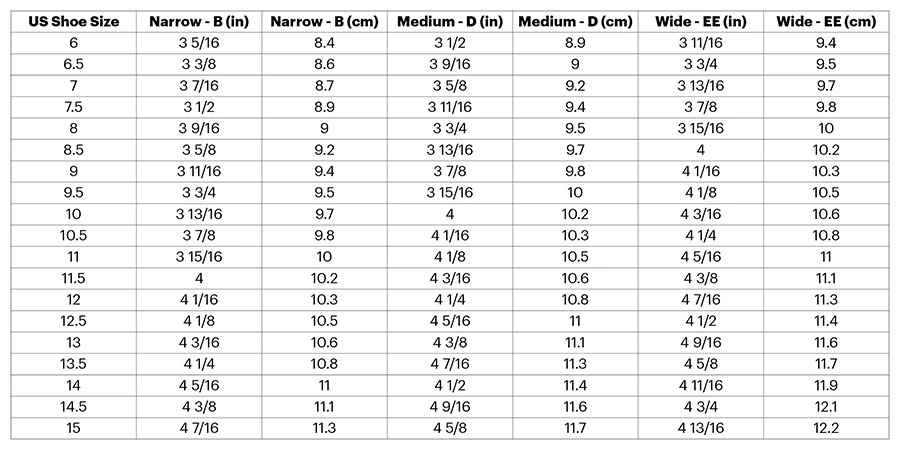
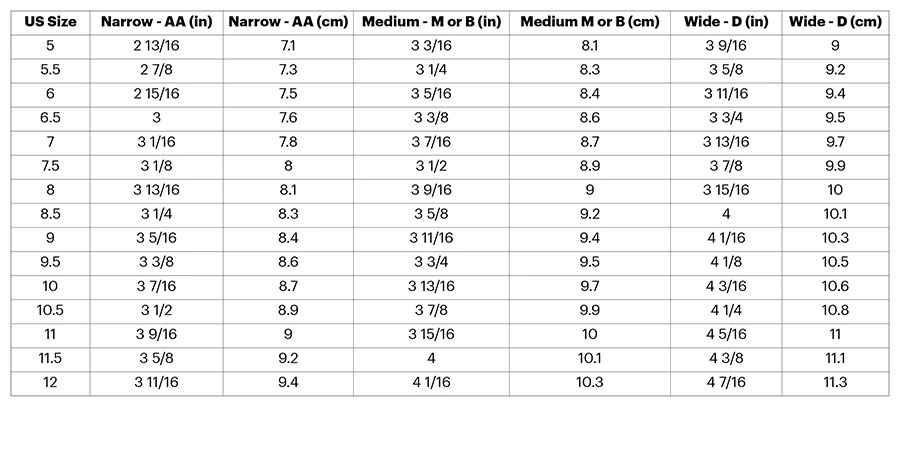
Signs That You Have Narrow Width Or Wider Width
The American Orthopaedic Foot & Ankle Society states that you shouldn’t always stick to the same shoe size because our foot shape and size can change with time, owing to weight gain, age, or normal changes in ligaments and tendons.
That said, a wider fit simply means more wiggle room and a snug but not tight middle and heel fit. At the same time, a narrow shoe width means no excess room at the sides and a snug, not tight fit.
However, some signs imply you belong to either of these foot shapes.
In the case of narrow, having space in the sides of your feet when wearing shoes means you need a narrower fit. If the sides are rubbing against your feet, then that’s a tell-tale sign for you to get a wider fit.
If you’re wondering if there’s more to how should running shoes fit, then read the pointers below.
- There should be a thumb’s space difference between your toes and the wall of the shoe’s forefront.
- The fit should be snug, not tight.
- The perfect running shoes fit generally should be half an inch larger than your casual shoes.
- Racing or running shoes have a tighter fit overall as it helps with fast flexes when on the run. Though, excessive space could cause your feet to slide out, so be careful.
- You could always trust socks to fill the space gap. Use thick socks for a snug fit and thin ones for a more relaxed fit.
- Anything that causes soreness, blisters, and numbness on the top, sides of the feet, or toes means you’re wearing the wrong size. A secure fit does not necessarily imply a painful fit.
Additional Tips on How Should Running Shoes Fit
Like with most things, good research before buying a product pays off, and you should never compromise on it when purchasing running shoes. The deeper knowledge you have of the product, the more likely you’ll not be distracted by useless products and their features.
Thus, we’ve researched how running shoes fit so that you can make an informed choice.
- If you’re shopping online for a shoe, pick one with an easy return policy to be on the safer side.
- Always read customer reviews and anything regarding the potential shoes.
- If you’re shopping from a store, ask for a trial run with your potential running shoes.
- Always visit the store when the most experienced staff is available and the shop’s less busy so that they can give their full attention to you.
- This is optional but buy from a brand you trust and fits your shoe size expectations the best.
- Put on the socks you intend to wear with running shoes. If you use custom orthotics, trial them as well with your desired running shoes.
- Always get a fit when your feet swell during the day: that’s the best time to try and purchase new shoes.
- If you have any special foot conditions, discuss them with a fit specialist.
Always perform a new measurement of your shoe size every time you buy shoes.
Frequently Asked Questions
Should running shoes be a size bigger?
Yes, the size of running shoes should be half an inch bigger than your casual shoes. Though, a lot of factors need to be considered that we’ve discussed above. Just make sure the fit doesn’t constrict your movements and can be used with accessories like socks, inserts, heel cups, and anything you plan to wear with running shoes.
How much room should be in the toe of a running shoe?
Basically, a thumb’s difference. In better words, enough to spread your toes without touching the forefront end.
How do you know if your running shoes are too big?
When your feet slip out from the back, and the sides feel empty, that’s when you know they’re too big and not how should running shoes fit.
Is it better for shoes to be tight or loose?
That depends! A tighter fit in running shoes might be better to pick up the pace when running. Though if a loose fit could be balanced with socks, that’s fine too. But the best solution is to get the correct running shoe size so you don’t end up putting yourself at risk.
Conclusion
I hope you find this post helpful. If you do or have additional questions to ask, hit me up in the comments section. If you have good suggestions of your own on how should running shoes fit, we’ll be more than happy to know.

